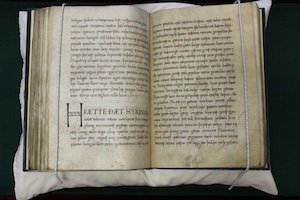Pope Gregory IX sent Henry a letter, chastising him for his treatment of Hubert who had been so loyal and helpful for so long. Henry did not want to disobey the pope: not only was he a faithful Christian, but his father, King John, had offered England as a vassal state to the papacy during his troubles, expecting that papal support would be enormously useful against his barons and France. Henry gave Hubert back his status as Earl of Kent, but only some of the lands he had formerly possessed.
In 1234, some of Hubert's enemies, including the king's former tutor, the French Peter des Roches, were dismissed from court (there was some anti-French feeling among the increasingly "English-oriented" Anglo-Norman country). This made Hubert's life even easier, until 1236, when the king found out about Richard de Clare.
Richard de Clare was the young Earl of Gloucester. In 1236 he was only 14 and the king's ward, but Henry had asked Hubert to raise him. While in Hubert's care, Hubert had married his daughter Margaret to Richard, although they were both children. This had been done without the king's blessing or his knowledge. The earldom of Gloucester was large and powerful, and Henry realized this alliance would potentially give more power to Hubert's family. Hubert's argument when called to court was that he was in sanctuary from the king's wrath at the time and had nothing to do with it. The king was ultimately convinced of Hubert's lack of involvement, but the marriage ended—we're not sure by annulment or Margaret's death. (Richard de Clare married Maud de Lacy, daughter of the Earl of Lincoln.)
Henry did not give up, however (we just don't know why he wanted so desperately to destroy Hubert). Hubert was accused by Henry of deliberately losing Poitou to the French, inappropriately seducing the Scottish princess who was his wife (his daughter Margaret's mother was Princess Margaret of Scotland, daughter of William the Lion and sister of Alexander II), and even attempting to assassinate Henry. Hubert's lawyer successfully defended him against all the charges. Hubert retired to his estates and stayed out of the public eye until his death on 12 May 1243. He had two sons from his first marriage, but they were not allowed to inherit the earldom, as it was limited to descendants of Hubert and his third wife, Margaret. They only had the one daughter.
In between those two was a second marriage, to the queen of England! That is a story worth telling next time.

















du.jpg)







